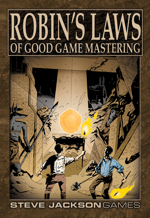“Who Framed Roger Rabbit” is one of my top 3 movies of all time so this short “oral history” article is very much my jam, especially seeing the early animation test: https://io9.gizmodo.com
The Stochastic Game
TTRPG hot take: if “system matters” at your table, you might not be playing a role playing game, and instead be playing a narrative board game
Watched Tremors last night with the older kid. He said it’s not very scary, so it’s “less of a horror movie, and more of a thriller”.
“Robin’s Laws of Good Game Mastering” is indeed the best GMing book around, if only because it’s super short and to the point. Recommended! http://www.sjgames.com

This is really good: “Just Because They’ve Turned Against Humanity Doesn’t Mean We Should Defund the Terminator Program” https://www.mcsweeneys.net
Treasures of Glorantha is out on the Jonstown Compendium! I did a couple of illustrations in there. The affiliate link is not for me, it’s for the author… enjoy and share! #Glorantha https://www.drivethrurpg.com

Looks like all interesting children books start with a 12 year old main character… What recommendations do you have for 8-11yo readers besides Harry Potter and Roald Dahl stories?
Warm-up sketches! Doing a few basic random #Glorantha clan people.


I’ve been playing the first Monkey Island (remastered) with the kids and… let’s say there’s been a lot of pirate insults thrown around lately. Also: they love speaking like Stan the salesman, especially the manic hand waving!
I am completely baffled by how the 13th Age rulebook assumes prior knowledge of D&D: it doesn’t list or explain character abilities! The only list is a short parenthetical (p30), and the only explanation is in the index entry (p310+).